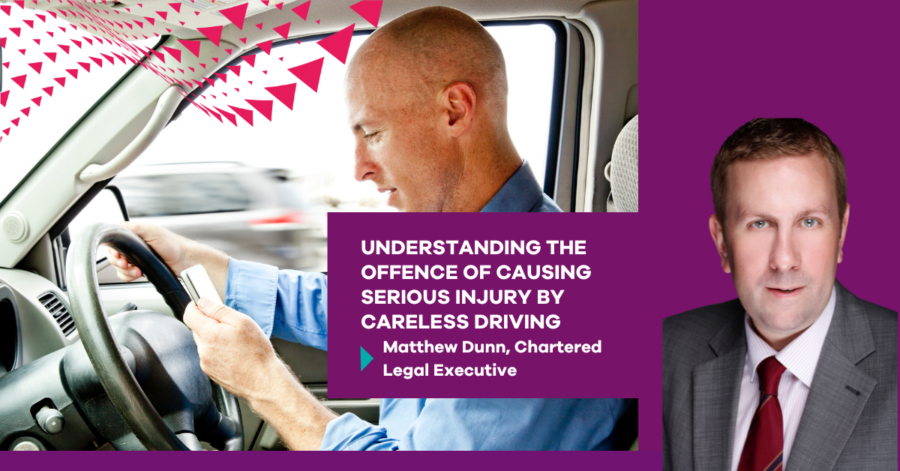Understanding the offence of causing serious injury by careless driving in the context of a RTA personal injury claimant


In road traffic accident (RTA) personal injury law, the criminal offence which usually arises is careless driving.
The offence of careless driving (interchangeable with driving without due care and attention) from s.3 of the Road Traffic Act 1988 , offers a range of sentencing between 3 – 4 driving licence points, up to 7 – 9 driving licence points or for the court to consider disqualification. An unlimited fine can also be imposed and the charge can only be heard summarily, i.e. at the Magistrates Court.
Several factors are considered in sentencing to reflect the seriousness of the offence or mitigation, including driving contrary to medical advice, excessive speed, aggressive driving, and previous convictions. Notably, causing injury to others is included as a factor indicating greater harm i.e. aggravating the offence.
In June 2022 a new, additional offence of causing serious injury by careless driving was introduced, which has implications for RTA claimants where criminal proceedings are taken against a defendant.
This new offence came into force on 28th June 2022 following the Police, Crime and Sentencing Act 2022, which inserted the offence into S.2C of the Road Traffic Act 1988. The only difference between the outcome is that someone has suffered serious injury – the standard of driving is the same as the existing careless driving offence.
The range of sentencing is however wider than before, given that the new offence is more serious – from a community order to 2 years custody and includes an obligatory driving disqualification. The case is triable either way and can therefore be heard in the Crown Court. More serious harm, which aggravates the offence is considered where “particularly grave and/or life threatening injury is caused”, “the injury results in physical or psychological harm resulting in life long dependency on third party car or medical treatment” or “results in a permanent irreversible injury or condition which has a substantial and long term effect on the victim’s ability to carry out normal day to day activities or on their ability to work.”
In the context of RTA personal injury this means that where a claimant has sustained catastrophic injuries, this would inevitably aggravate the offence and subsequent sentencing imposed on the defendant.
The threshold for “serious injury” is physical harm which amounts to grievous bodily harm for the purposes of the Offences against the Person Act 1861. The level of injury sustained is set out in a plethora of criminal case law and defined as really serious bodily harm. In most multi-track cases the injuries sustained would meet the threshold for a charge of causing serious injury by careless driving, and would be inevitable for a catastrophically injured claimant.
Bearing in mind that criminal convictions for these offences relate primarily to matters of liability, the new offence does not change how a RTA claimant would present their case. However, it is preferable for a claimant that a defendant in a multi-track case is convicted of causing serious injury by careless driving, rather than careless driving, for several reasons.
The new offence gives recognition to a claimant for the seriousness of his or her injuries, which might give a claimant an acknowledgement of their pain and suffering. A defendant convicted of the offence faces much more serious sentencing, including an obligatory driving ban and potential imprisonment, which in the case of a catastrophically injured claimant, might offer a better sense of justice being served.
Whilst a conviction seems highly unlikely to play into the assessment of quantum, it may encourage a defendant insurer to take more notice of a case and may increase their willingness to engage in the rehab code and in providing interim payments. The impact however is unlikely to be significant given that the seriousness of the injuries sustained will be better defined in the claimant’s Part 35 evidence and medical records in any event.
In conclusion, it would be preferable in a multi-track RTA case for a defendant to be convicted of causing serious injury by careless driving, in place of careless driving. The conviction will not change the liability position compared to careless driving as the standard of driving is the same, but most multi-track cases are now likely to fall within the definition of “serious injury” or “really serious bodily harm”, and catastrophic injuries will inevitably do so. As a RTA multi-track personal injury practitioner, this offence is now likely to be seen more and more often and offers some benefits to a claimant but is very unlikely to bear fruit in relation to the assessment of liability and quantum compared to the existing offence of careless driving.